|
Home >European
Touring > Europe 2007 > Spain 2007 - Costa Verde
to the Northern Plains
|
|
From the Costa Verde to
the Northern Plains
|
Entering Spain through the industrial town
of Irun we parked up at the modern marina at Hondaribbia across the
estuary from Hendaye for lunch then drove along the main road to Donostia-San
Sebastian which looked smart in the old town centre but in torrential rain having not yet got
used to Spanish/Basque road signs we managed to end up heading south on a busy dual
carriageway with fast trucks to Tolosa where we turned
off for a break and a study of the maps. We took the quiet but attractive
road through the hills to Azpetia and the Jesuit shrine of St Ignatius
Loyola, a severe building from the outside with a magnificent dark marbled interior.
From there we drove back to the coast and after overnighting in more heavy
rain at a small
but expensive campsite at Itxaspe, drove to Deba a small and deserted resort.
Continuing along the coast road we again got lost in the narrow streets of
Ondarroa before arriving at Lekeitio, another resort that is probably much
more interesting on a hot summer's day!
|
After another wet night at the campsite at
Mendexa we decided that the Costa Verde was living up to its name so
headed inland, eventually on a good road after diversions on
country lanes due to road closures, to the bypass of Vitoria Gastiez where
we had a fright expecting to join a slip road for the motorway but
realising just in time that it was in
fact a tee junction! After a circuit (or two) of Miranda de Ebro an
industrial town with many modern apartment blocks in the middle of a very large
flat plain we found a small road marked in green (picturesque) on the
Michelin map. After 18 kilometres of potholes and single track we ended up
at Haro, just in the Rioja region where the town was buzzing with the
build up to a bull fight. While the pageantry and processions through the
town were interesting we gave the actual event a miss.
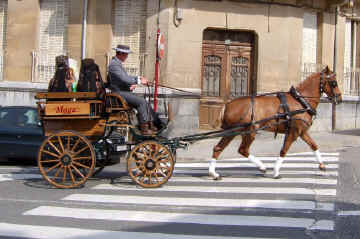
On
their way to the bullfight
|
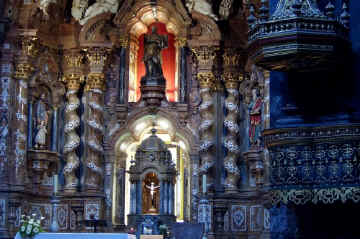
Interior of St Ignatious Loyola Basilica
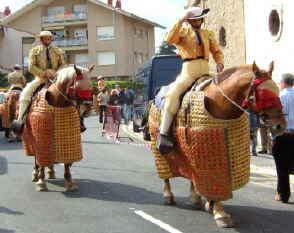
Picadors at Haro
|
Studying the many guidebooks to Northern Spain and notes from websites we
had brought with us, we
continued heading south to the walled town of St Domingo de la Calzada on
el Camino de Santiago, where there were many
walkers, some cyclists and one person with a donkey, (The pilgrims route
is frequently marked with a shell symbol and nowadays with modern signs.
The Compostela is the certificate earned by walkers completing at least
100km and for cyclists 200km). After
watching the many storks nesting on the town walls, we drove south to the large twin
monasteries of Yuso and Suso set in the wooded hills of the Sierra de la
Demanda nature reserve. There was a small campsite nearby at Berceo mostly
small static caravans with elaborate awnings, barbecues, flowers in tubs etc.
which we presumed were used as weekend retreats.
From there we turned east to Logrono then south to the prehistoric park at
Enciso where there were impressive dinosaur footprints in the rocks, the
most accessible of more than 5000 in this area. There were a few replica
animals but no gift shop cafe or bar as there would be in France, just a
children's play area and some informative display boards.
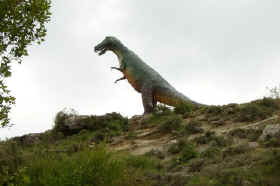
Dinosaur at Enciso
Driving past many caves in the cliffs surrounding the industrial towns of
Arnedo and Autol we took a detour to the town of Falces with a chapel and
shrine on the cliffs overlooking the flat plains and eventually arrived at
Olite for a peaceful night wild camping outside the cemetery on the edge
of the town (we discovered the listed campsite which was all statics the
next morning). Olite has a large castle in the old walled town centre with
many towers and turrets and is worth a stroll around. There is an old
decorated palace now a Parador (state run hotel)
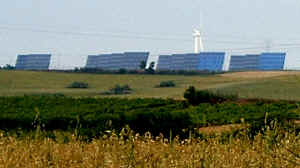
Solar panels near Olite
|
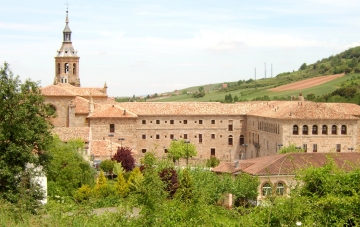
Monastery de Yuso
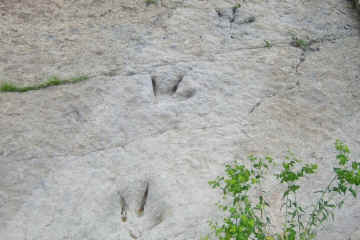
Dinosaur footprints at Enciso
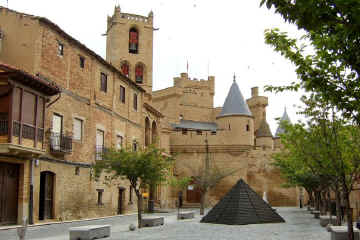
Olite Castle and town square
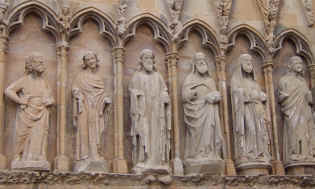
Saints on palace façade at Olite
|
Our zizag route led us past massive banks of
solar panels and wind farms to the strange desert region of the La
Bárdenas Reales de Navarre and another diversion at Valtierra, following nature park
signs on a new road which led us to a deserted theme park and zoo (Sendaviva
- possibly open in the afternoons) so we visited another hilltop chapel
nearby at the sanctuary of the Virgin del Yugo hoping for
more extensive views of the Arizona style rock formations but we
were thwarted by heavy rain and a thunderstorm.
After driving through large flooded rice? fields we stopped on the
bypass of the larger town of Tudela where there were several supermarkets
then we headed east
through the "desert" then north towards the Pyrenees
through ever more mountainous terrain to Sos del Rey Católico and on
another narrow winding road to Ruestes, a
ruined village with graffiti covered buildings and a hostel on the Camino de Santiago
and apparently used for Anarchist party gatherings.
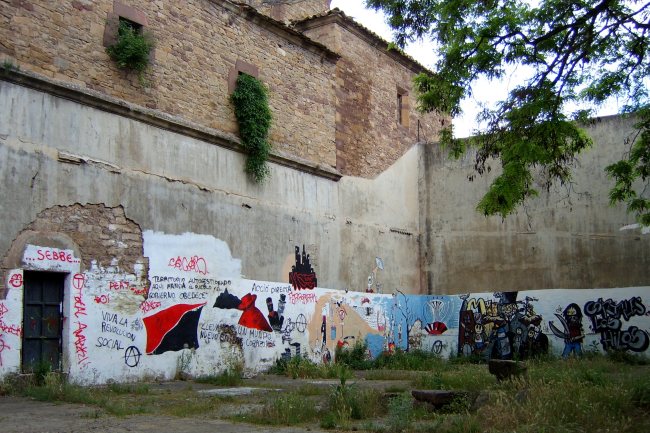
Ruestes graffiti covered walls
Descending into the valley we arrived at the Embalse de Yesa,
a turquoise reservoir surrounded by strange mounds of smooth grey shale. After a
night at the campsite near Sigués where there was a huge Belgian
registered American RV with additional cars, tents, powerboats and canoes
(did they pay just the standard pitch fee?), we drove along the northern
side of the lake to the Monasterio de Leyre then on to Lumbier and the Foz (gorge - parking
was €2, one of the few times we had to pay while in Spain), impressive cliffs with a path
along an old railway track through two tunnels and popular with
birdwatchers. Heading north east we climbed into the wooded foothills of the Pyrenees
on a good road passing another viewpoint
into the deep and inaccessible Foz de Arbayun and on to the Passo
las Coronas 950m where there was a picnic site, unfortunately vandalised, with fine views
into the Valle de Roncal and the snow capped Pyrenees. After Roncal we took the road to Anso which was
good for 4km then followed 6km of potholes with a few concrete post barriers on
some of the sharper bends. Luckily we only met two cars. At Anso the
village was virtually deserted and the campsite closed so we had a long
drive across rough countryside through the narrow Foz de Biniés
(wondering whether to stop and wildcamp for the night) and the
main road at last where we headed for the nearest campsite which was the
excellent Camping Pirineos at Santa Cilia de Jaca.
The next morning we drove to Jaca an
important administrative centre since Roman times and now a busy town, for
some shopping then retraced our route back to the crossroads at Puente la
Reina de Jaca turning south on the virtually empty main road towards
Huesca. After stopping to look at the large sandstone rocks of Los Mallos
we turned off to the village of Loarre and the delightfully situated
Camping de Castillo de Loarre pitching among shady olive trees, (welcome
now that the weather was hot and sunny for a day or so!) with fine views
of the large castle and the extensive plains to the south. After tea we
enjoyed an hour's walk up to the castle but found it closed just as we
arrived at 7pm
|
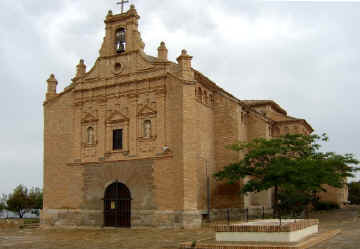
Sanctuary of the Virgin del Yugo
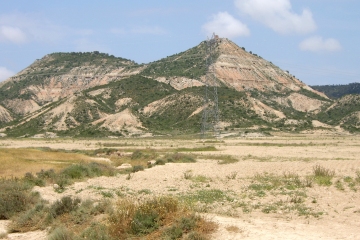
Bárdenas Reales de Navarra
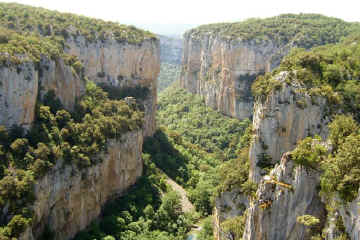
Foz de Arbayun near Lumbier
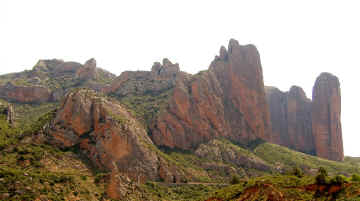
Los Mallos near Ayerbe
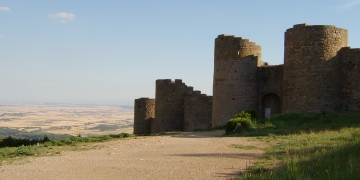
View from Castillo de Loarre
|
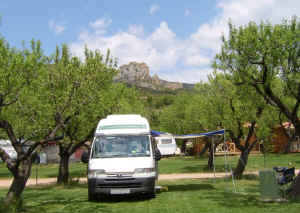
Camping Castillo de Loarre
|
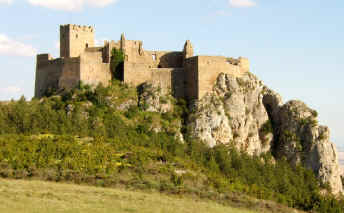
Castillo de Loarre
|
|
The next day we decided to drive the short
distance to Huesca for a supermarket top-up then to turn north through
the Pyrenees as we were finding that travelling west to east was proving
to be slow and difficult with narrow winding north-south roads up heavily wooded
valleys. We stopped briefly at Biesca where there was a tragedy in
August 1996 when 87 people were killed as the campsite was washed away
in a flash flood, then a slow but steady climb past the expanding ski
resort of el Formigal. Crossing the easy Col du Pourtalet route back into
France it was a pleasant drive down to Laruns, pausing at
Artouste-Fabrèges where a mountain railway runs to a lake high in the
mountains (but it's a full day's trip).
|
|
<< France
Basque country
|
the French Pyrenees >>
|
| top | Home
| Europe 2007 | Europe
07 campsites | European
Touring | UK Touring |
|